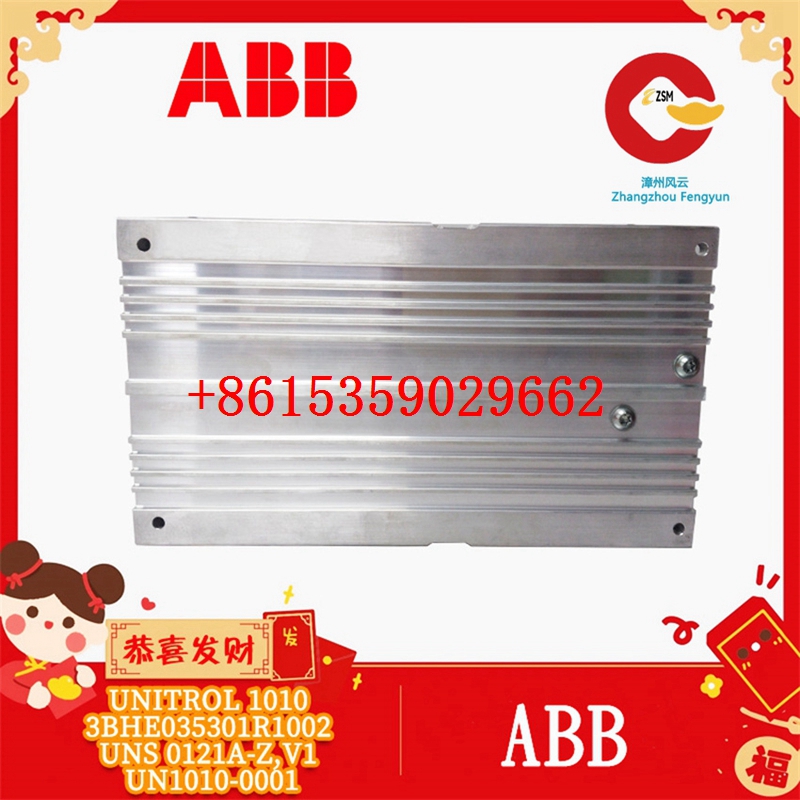Technical Parameters of ABB RDI01A 2VAA008429R11 Symphony Plus Digital Input Module
1. General Overview

The ABB RDI01A 2VAA008429R11 Digital Input Module is an integral part of the ABB Symphony Plus distributed control system (DCS). It is designed to interface with digital sensors and signals in industrial processes, providing reliable data acquisition for monitoring and control purposes. This module enhances the functionality of the Symphony Plus system by enabling accurate and efficient digital signal input.
2. Electrical Specifications
2.1 Input Characteristics
- Number of Input Channels: The module typically offers a specific number of digital input channels, such as 16 or 32, depending on the configuration. This allows for the connection of multiple digital sensors or devices, reducing the need for additional modules and simplifying system design.
- Input Voltage Range: It can accept a wide range of input voltages to accommodate different types of digital sensors. Common input voltage ranges include 24 V DC ± a certain percentage (e.g., ±15%). This flexibility ensures compatibility with a variety of industrial sensors and signals.
- Input Logic Levels: The module defines clear logic levels for the digital inputs. For example, a high – level input may be considered valid when the voltage is above a certain threshold (e.g., 18 V DC), and a low – level input when the voltage is below another threshold (e.g., 5 V DC). This helps to distinguish between different digital states accurately.
2.2 Power Supply
- Power Consumption: The module has a relatively low power consumption, which is an important consideration for energy – efficient industrial installations. The exact power consumption value depends on the number of active input channels and the module’s operating mode, but it is usually in the range of a few watts.
- Power Supply Voltage: It requires a specific power supply voltage, typically 24 V DC, to operate. The power supply should be stable and within the specified voltage range to ensure reliable module performance.
3. Communication and Interface
3.1 Communication Protocol
- The RDI01A module communicates with the Symphony Plus system using a standard communication protocol, such as Profibus DP, Modbus, or a proprietary ABB protocol. This enables seamless integration into the existing DCS architecture, allowing for real – time data exchange between the digital input module and the control system.
- Communication Speed: The communication speed can vary depending on the protocol used. For example, in a Profibus DP network, the communication speed may range from 9.6 kbit/s to 12 Mbit/s, providing fast and efficient data transfer.
3.2 Backplane Interface
- The module is designed to connect to the Symphony Plus backplane, which serves as the communication and power distribution bus within the DCS. The backplane interface ensures reliable electrical and mechanical connections between the module and the rest of the system.
4. Environmental Specifications
4.1 Operating Temperature
- The module can operate reliably within a specified operating temperature range, usually from -20°C to +60°C (or a similar range). This allows it to be used in a variety of industrial environments, including those with extreme temperature conditions, such as factories, power plants, and oil refineries.
4.2 Humidity
- It is designed to withstand a certain level of humidity, typically up to 95% non – condensing. This makes it suitable for use in humid industrial environments, such as paper mills or food processing plants, where moisture may be present.
4.3 Vibration and Shock Resistance
- The module meets specific vibration and shock resistance standards to ensure reliable operation in environments with mechanical vibrations, such as on machinery or in vehicles. For example, it may comply with IEC 60068 – 2 – 6 for vibration and IEC 60068 – 2 – 27 for shock, providing long – term durability and stability.
5. Mechanical Specifications
5.1 Form Factor
- The RDI01A module has a standard form factor that is compatible with the Symphony Plus system cabinets. It is typically designed to fit into a specific slot in the cabinet, allowing for easy installation and replacement.
- Dimensions: The module has specific physical dimensions, which are important for mechanical layout and system design. The length, width, and height are usually measured in millimeters (mm). For example, it may have dimensions of approximately 100 mm (length) × 150 mm (width) × 50 mm (height).
5.2 Mounting Method
- It can be mounted using standard mounting techniques, such as DIN rail mounting or panel mounting. This provides flexibility in system installation and allows for easy integration into different industrial setups.
6. Diagnostic and Status Indicators
6.1 LED Indicators
- The module is equipped with LED indicators that provide visual feedback on the status of the inputs and the module itself. For example, there may be LEDs to indicate power on, communication status, and the state of each input channel (high or low). This allows operators and maintenance personnel to quickly diagnose any issues and monitor the module’s operation.
6.2 Diagnostic Functions
- The Symphony Plus system can perform diagnostic functions on the RDI01A module, such as checking for input channel faults, communication errors, and power supply problems. These diagnostic capabilities help to improve system reliability and reduce downtime by enabling early detection and correction of issues.
7. Certifications and Compliance
7.1 Industrial Standards
- The module complies with various international industrial standards, such as IEC 61131 – 3 for programmable controllers and EMC (Electromagnetic Compatibility) standards like EN 61000 – 6 – 2 (for industrial environments) and EN 61000 – 6 – 4 (for industrial emissions). These certifications ensure that the module meets the highest levels of safety, reliability, and electromagnetic compatibility requirements.
7.2 Regulatory Approvals
- It may have regulatory approvals from relevant authorities in different regions, such as UL (Underwriters Laboratories) in the United States, CE marking in Europe, and CCC (China Compulsory Certification) in China. These approvals facilitate the installation and use of the module in various countries around the world.
In summary, the ABB RDI01A 2VAA008429R11 Symphony Plus Digital Input Module is a reliable and versatile component for industrial digital signal input in the ABB Symphony Plus DCS. Its comprehensive electrical, communication, environmental, mechanical, diagnostic, and certification specifications make it a suitable choice for a wide range of industrial applications.


